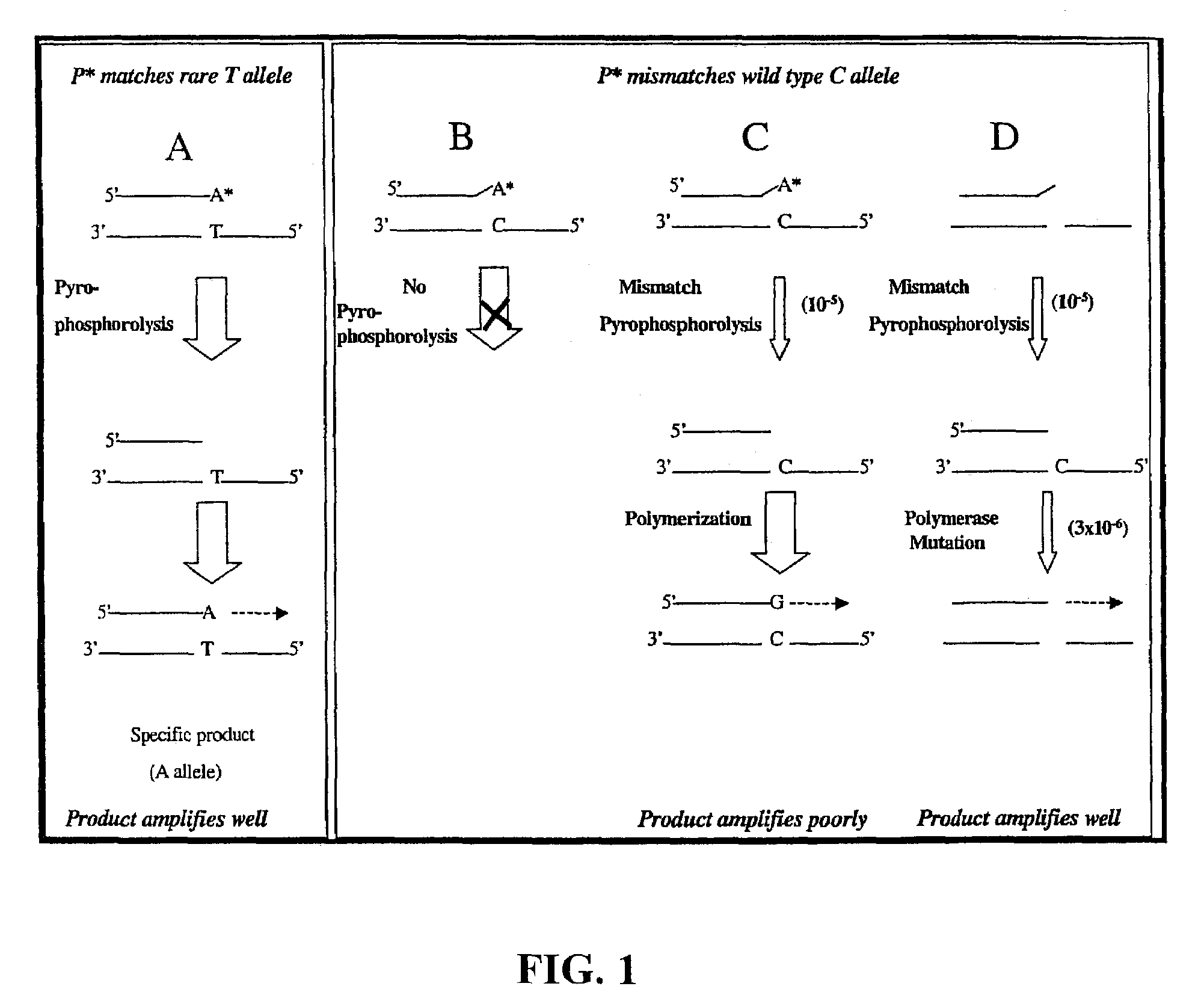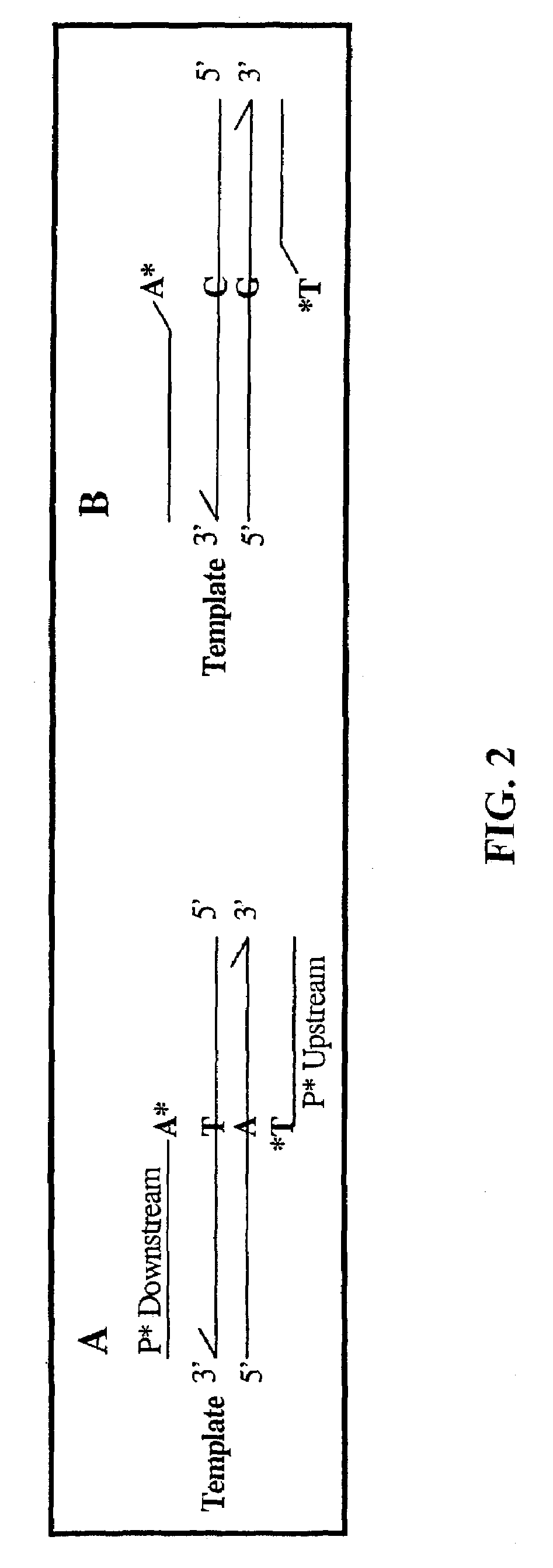Pyrophosphorolysis activated polymerization (PAP)
a pyrophosphorolysis and activated polymer technology, applied in the field of nucleic acid polymerization and amplification, can solve the problems of inability to achieve the highest specificity, inability to routinely analyze, and individuals with a high mutation load may be at increased risk of cancer, etc., to achieve the most efficient amplification and eliminate the error of incorporation
- Summary
- Abstract
- Description
- Claims
- Application Information
AI Technical Summary
Benefits of technology
Problems solved by technology
Method used
Image
Examples
example 1
Preparation of Template by PCR
[0196]A 640-bp region of the human D1 dopamine receptor gene was amplified by PCR with two primers (T=5′ GAC CTG CAG CAA GGG AGT CAG AAG 3′ (SEQ ID NO:1) and U=5′ TCA TAC CGG AAA GGG CTG GAG ATA 3′ (SEQ ID NO:2)) (FIG. 6A). The TU:UT duplexed product spans nucleotides 33 to 672 in GenBank X55760 and the G+C content is 55.3%. A common A to G polymorphism is located at nucleotide 229, resulting in three genotypes of G / G, A / A and G / A (Liu et al., 1995). The PCR mixture contains a volume of 50 μl: 50 mM KCl, 10 mM Tris / HCl, pH 8.3, 1.5 mM MgCl2, 200 μM each of the four dNTPs (Boehringer Mannheim), 0.1 μM of each primer, 2% DMSO, 1 U of Taq DNA polymerase (Boehringer Mannheim) and 250 ng of genomic DNA from G / G homozygote, A / A homozygote or G / A heterozygotes. Cycling conditions included: denaturation at 95° C. for 15 seconds, annealing at 55° C. for 30 seconds, and elongation at 72° C. for one minute, for a total, of 35 cycles (Perkin-Elmer GeneAmp PCR syste...
example 2
Preparation of Template by PCR
[0241]A 640-bp region of the human D1 dopamine receptor gene was amplified by PCR with two primers (T=5′ GAC CTG CAG CAA GGG AGT CAG AAG 3′ (SEQ ID NO:1) and U=5′ TCA TAC CGG AAA GGG CTG GAG ATA 3′ (SEQ ID NO:2)). The TU:UT duplexed product spans nucleotides 33 to 672 in GenBank X55760 and the G+C content of the product is 55% . A common A to G polymorphism is located at nucleotide 229, resulting in three genotypes of G / G, A / A and G / A. The PCR volume is 50 μl: 50 mM KCl, 10 mM Tris / HCl, pH 8.3, 1.5 mM MgCl2, 200 μM each of the four dNTPs, 0.1 μM of each primer, 2% DMSO, 1 U of Taq DNA polymerase (Boehringer Mannheim) and 250 ng of genomic DNA from G / G homozygote, A / A homozygote or G / A heterozygotes. Cycling conditions included: denaturation at 94° C. for 15 sec., annealing at 55° C. for 30 sec., and elongation at 72° C. for one min., for a total of 35 cycles with a GeneAmp PCR System 9600 (Perkin-Elmer Applied Biosystems). The PCR product was purified f...
example 3
[0281]PAP Amplification from Genomic DNA
[0282]This example illustrates PAP amplification directly from genomic DNA. The oligonucleotides used in this example are listed below. Lane numbers refer to lanes in FIG. 15.
[0283]The downstream oligonucleotides in 0.1 μM concentration are:
[0284]
Lane 1: D1(204)25D5′ TCTGACTGACCCCTATTCCCTGCTT 3′ (SEQ ID NO:43)Lane 2: P*(206)24A05′ TGACTGACCCCTATTCCCTGCTTA* 3′(A allele specific; SEQ ID NO:44)Lane 3: P*(204)26G05′ TCTGACTGACCCCTATTCCCTGCTTG* 3′(G allele specific; SEQ ID NO:45)Lane 4: P*(206)24G−25′ ACTGACCCCTATTCCCTGCTTGGG* 3′(G allele specific; SEQ ID NO:46)Lane 5: P*(228)26A−245′ TAGGAACTTGGGGGGTGTCAGAGCCC* 3′(A allele specific; SEQ ID NO:47)
[0285]The opposite upstream oligonucleotide in 0.1 μM concentration is: D1(420)24U 5′ ACGGCAGCACAGACCAGCGTGTTC 3′ (SEQ ID NO:48), which was paired with each downstream oligonucleotide. See Footnotes of Table 3 for details.
[0286]The other components were the same as in Example 2, except fo...
PUM
| Property | Measurement | Unit |
|---|---|---|
| pH | aaaaa | aaaaa |
| pH | aaaaa | aaaaa |
| volume | aaaaa | aaaaa |
Abstract
Description
Claims
Application Information
 Login to View More
Login to View More - R&D
- Intellectual Property
- Life Sciences
- Materials
- Tech Scout
- Unparalleled Data Quality
- Higher Quality Content
- 60% Fewer Hallucinations
Browse by: Latest US Patents, China's latest patents, Technical Efficacy Thesaurus, Application Domain, Technology Topic, Popular Technical Reports.
© 2025 PatSnap. All rights reserved.Legal|Privacy policy|Modern Slavery Act Transparency Statement|Sitemap|About US| Contact US: help@patsnap.com



